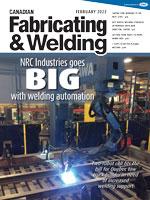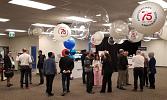Product Marketing Manager, Software
- FMA
- The Fabricator
- FABTECH
- Canadian Metalworking
Effective plasma nesting in 7 steps
Follow these practices to get the most out of your material
- By Tom Stillwell
- March 16, 2023
- Article
- Fabricating
Effective nesting can save a shop the cost of scrap materials, as well as the hidden costs of labour, time spent loading and unloading sheet, storage, and the environmental impact of processing more material than absolutely necessary.
Consider following these seven nesting practices to get the most out of your plasma table.
1. Use Advanced, Offline Nesting Software
If your shop is new to the cutting industry, you can get away with doing your nesting on the CNC itself or using a low-cost, off-the-shelf product because you’re not producing high volumes. That's fine for a while, but when you’re ready to take that next step, make sure you're using a more advanced offline nesting software, installed on a separate computer.
This software gives a shop speed and flexibility and can improve your plate use profile (how much of your overall plate is used for parts rather than scrap). Generally, these systems have advanced automatic nesting capabilities that can reduce your nesting process from 30 minutes to only 30 seconds.
2. Get to Know Your Nesting Strategies
With this type of software, you’ll have more advanced nesting strategies at your fingertips. For instance, something off the shelf with simple algorithms may only have rectangular nesting; such a program basically looks at a part, draws a rectangle around it, and then nests the part in blocks. With a program like that, you’re not making use of the space around the part, you're not getting true shape nesting.
True shape nesting—a feature that uses a more detailed nesting algorithm to nest objects based on their actual shape—makes a difference in how many parts you can get from a given plate. In one example I often show shops, it is possible to go from getting only 45 parts on a plate to 78 parts because the program allows the user to rotate and interlock parts.
System optimization is another nesting strategy with advanced software. With this feature, the software looks at all of the plates that you have available in inventory—different sizes and remnants—and determines which mix of plates will give you the best overall material use for the parts you want to nest.
3. Nest More Parts at Once
The more parts that you get into a single job, the more options the nesting algorithms have to work with and the better utilization rate you can get out of those parts. Any opportunity you have to combine jobs that are being cut from the same material, even if they both aren’t due immediately, will help increase your material use.
4. Always Fill the Sheet
How important is it to you to increase your material use? It's not always the top priority at every shop. Do you want to spend another 20 minutes of your time getting better utilization, or is your time spent better somewhere else? That's for each company, each person, to decide, but you can get better results, higher utilization, and save more on material and increase your profits if you get more parts on the plate.
One way to do that is by creating stock parts that you're going to need for regular orders. Add some stock parts to the empty space that you have to fill the plate, and then put those parts into stock for your next order.

True shape nesting—a feature that uses a more detailed nesting algorithm to nest objects based on their actual shape—makes a difference in how many parts you can get from a given plate.
Similarly, some companies will even create parts for sale, something they know they have a market for. Better to turn the extra material into a product than just put it into the scrap bin.
5. Consider Common Line Cutting
Using common line cutting—where two or more parts share a cut path and more than one part is cut at the same time—reduces the number of pierces in a sheet, the overall cutting distance over the sheet, and scrap. Depending on the parts involved, it’s possible to go from 75 per cent to 90 per cent sheet utilization with common line cutting. And using fewer pierces will lengthen consumable life as well.
With plasma cutting, one side of the cut generally is cleaner than the other (due to the swirl of the plasma and the taper it creates), so it’s important to consider how common line cutting might affect your part tolerances and whether it meets your end customer’s needs.
6. Manage Lead-ins and Separations
The lead-in to a plasma cut allows your plasma to steady itself for the pierce and pierce puddle without damaging your part. On thick plate, longer lead-ins are required, which means more space is needed between parts so the lead-in and pierce don’t affect adjacent parts.
The lead-in normally is set automatically to achieve the best part quality, but advanced users can shorten it enough manually to gain more parts from the same sheet. However, shortening the lead-in can create a risk for part damage. If you are going to shorten your lead, test first and dial in the changes so you don’t damage the part and create more waste. It’s also important to consider how heat-affected zones can affect adjacent parts, particularly on thinner plate. It may be that a nest needs to be modified to spread out parts where heat is going to be concentrated.
More advanced cutting systems now can be equipped with software that can make lead-ins shorter automatically by more quickly stabilizing the arc on the plasma torch. This is particularly useful if you are cutting a number of rectangular parts. If your nest includes a lot of rounded parts, the spaces between these parts create plenty of waste area that can be used for a lead. The shorter the lead on a nest of rectangular parts, the more room for additional parts. Using the technology can increase material use by an average of 3 per cent. This may not seem like much, but over the course of a year, it can have a serious impact on a shop’s bottom line.
7. Track Your Data
It’s important to track your scrap, whether you do so with software or with a manual log. Using this data, you can find the jobs in your shop with the worst scrap rate and target them for improvement. Shop waste, while it may not seem so, is a hidden bottleneck on your floor. The time spent removing and disposing of that waste, and the parts you haven’t managed to glean from that material, are a drain on your profits.
Tom Stillwell is product marketing manager, software, with Hypertherm Associates, 21 Great Hollow Road, Hanover, NH 03755, 603-643-3441, tom.stillwell@hypertherm.com, www.hypertherm.com.
About the Author
subscribe now


Keep up to date with the latest news, events, and technology for all things metal from our pair of monthly magazines written specifically for Canadian manufacturers!
Start Your Free Subscription- Industry Events
MME Saskatoon
- May 28, 2024
- Saskatoon, SK Canada
CME's Health & Safety Symposium for Manufacturers
- May 29, 2024
- Mississauga, ON Canada
DiPaolo Machine Tools Open House 2024
- June 4 - 5, 2024
- Mississauga, ON Canada
FABTECH Canada
- June 11 - 13, 2024
- Toronto, ON Canada
Zoller Open House & Technology Days 2024
- June 12 - 13, 2024
- Ann Arbor, MI






















